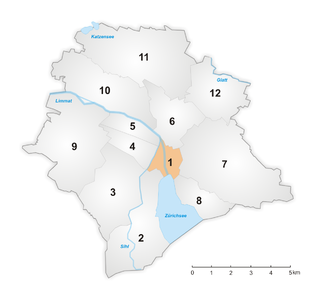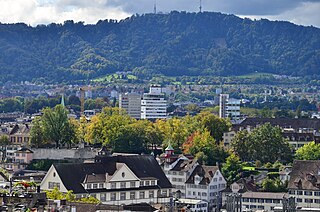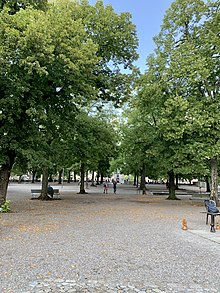
Zurich has been continuously inhabited since Roman times. The vicus of Turicum was established in AD 90, at the site of an existing Gaulish (Helvetic) settlement.

St. Peter is one of the four main churches of the old town of Zürich, Switzerland, besides Grossmünster, Fraumünster and Predigerkirche.

The Altstadt in the Swiss city of Zurich encompasses the area of the entire historical city before 1893, before the incorporation of what are now districts 2 to 12 into the municipality, over the period 1893 to 1934. Die Altstadt approximately corresponds to the area enclosed by the former city ramparts, and is today within the administrative area of the city called Kreis 1.

Rennweg is a medieval main road and is today part of the inner-city pedestrian zone of Zürich, Switzerland. A rennweg was in the medieval German speaking territories a street where horses were moved. Once, it was one of the nodal points of road and public transportation. Today, as well as the Limmatquai, as well as Augustinergasse, it is a section of the southern extension of the Seeuferanlage promenades that were built between 1881 and 1887. Rennweg is one of the best known visitor attractions of the oldest area of the city of Zürich.
Zürich was an independent (reichsfrei) city or city-state from 1218 to 1798. The town was fortified with a city wall from the 13th to the 17th century, and with more elaborate ramparts constructed in the 17th to 18th century and mostly demolished in the 1830s to 1870s.

Schipfe is a residential district in Zurich, Switzerland, located on the eastern slope of the Lindenhof, one of the oldest parts of the Helvetii Oppidum Zurich-Lindenhof, by the river Limmat. Historians and the Weinplatz suggest that the district was part of the former civilian harbour of the Celtic-Roman Turicum.

The Lindenhof is a moraine hill and public square in the historic center of Zurich, Switzerland. It is the site of the Roman and Carolingian era Kaiserpfalz around which the city has historically grown. The hilltop area—including its prehistoric, Roman, and medieval remains—is listed as a Swiss heritage site of national significance.

Rapperswil is a former municipality and since January 2007 part of the municipality of Rapperswil-Jona in the Wahlkreis (constituency) of See-Gaster in the canton of St. Gallen in Switzerland, located between Obersee and the main part of Lake Zurich.

Rapperswil Castle is a castle, built in the early 13th century by the House of Rapperswil, in the formerly independent city of Rapperswil.

Augustinergasse is a medieval lane that today is part of the innercity pedestrian zone of Zürich, Switzerland. It is named after the former Augustinian Abbey that is now Augustinerkirche, the former church of the convent that was disestablished in 1525. Once, it was one of the nodal points of road and public transportation between Münsterhof, St. Peterhofstatt, the present Münzplatz plaza at the former abbey, and one of the gates and fortifications of the medieval town walls. Today, as well as the Limmatquai, Augustinergasse is a section of the southern extension of the Seeuferanlage promenades that were built between 1881 and 1887, and one of the best known visitor attractions of the oldest area of the city of Zürich.

Münsterhof is a town square situated in the Lindenhof quarter in the historical center of Zürich, Switzerland. It is the largest town square within the Altstadt of Zürich, and is surrounded by medieval buildings. The area forms part of the southern extension of the Quaianlagen promenades along Zürich's lakefront.

Zurich is the largest city in Switzerland and the capital of the canton of Zurich. It is located in north-central Switzerland, at the northwestern tip of Lake Zurich. As of January 2023, the municipality had 443,037 inhabitants, the urban area 1.315 million (2009), and the Zurich metropolitan area 1.83 million (2011). Zurich is a hub for railways, roads, and air traffic. Both Zurich Airport and Zurich's main railway station are the largest and busiest in the country.

Turicum was a Gallo-Roman settlement at the lower end of Lake Zurich, and precursor of the city of Zurich. It was situated within the Roman province of Germania Superior) and near the border to the province of Raetia; there was a tax-collecting point for goods traffic on the waterway Walensee–Obersee-Zürichsee–Limmat–Aare–Rhine.

Grossner Hafner is one of the 111 serial sites of the UNESCO World Heritage Site Prehistoric pile dwellings around the Alps, of which are 56 located in Switzerland.

Lindenhof in Rapperswil is a moraine hill and a public square being the historic center of Rapperswil, Switzerland.

Rathausbrücke is a pedestrian bridge which crosses the river Limmat in Zurich, Switzerland. It is colloquially named Gmüesbrugg, and is a popular public square connecting Limmatquai, and the Weinplatz plaza and the historical Schipfe quarter.

Lindenhof is the present name of the large fortified settlement, or oppidum, likely founded by the Helvetii on the Lindenhof hill on the western shore of the Limmat in Zurich, Switzerland.

Augustinerkirche was once one of the five main churches in the old town of Zürich, Switzerland, together with Fraumünster, Grossmünster, Predigern and St. Peter's. First built around 1270 as a Romanesque church belonging to the Augustinian abbey, on occasion of the Reformation in Zürich worship in the church was discontinued. The present Christian Catholic Church community of Zürich planned to rebuild the building to commemorate the old Augustinian church, and for the same reason, Augustinerkirche is still their Parish church, that was rebuilt in 1843/44 by Ferdinand Stadler. In the late 1950s, the church was rebuilt in accordance with the plans for the original structure. Today the building is one of the three medieval churches in the Lindenhof district of the city of Zürich.

Augustinerkloster was one of the eight monasteries within the medieval city of Zürich in Switzerland. It was founded around 1270 as an Augustinian Order priory on the site of the present Augustinerkirche Zürich on Münzplatz, and was abolished in 1524.

Weinplatz is a popular public square adjacent to the Gmüesbrugg bridge and the historical Schipfe quarter.



















